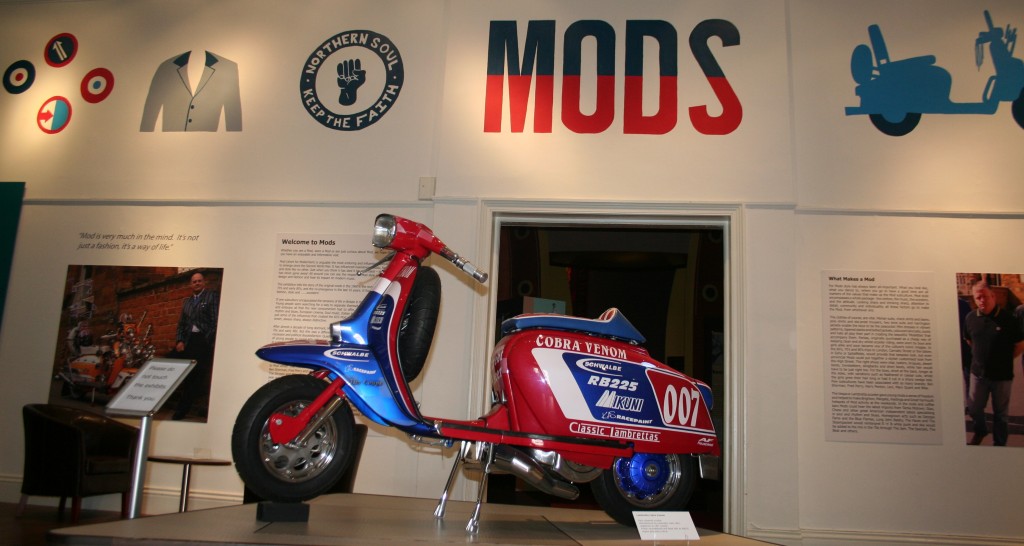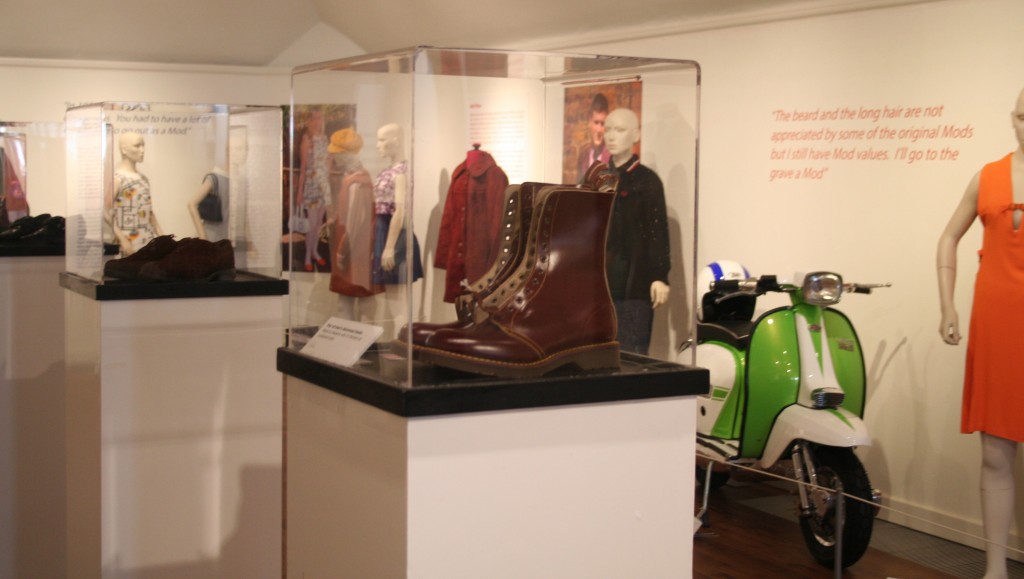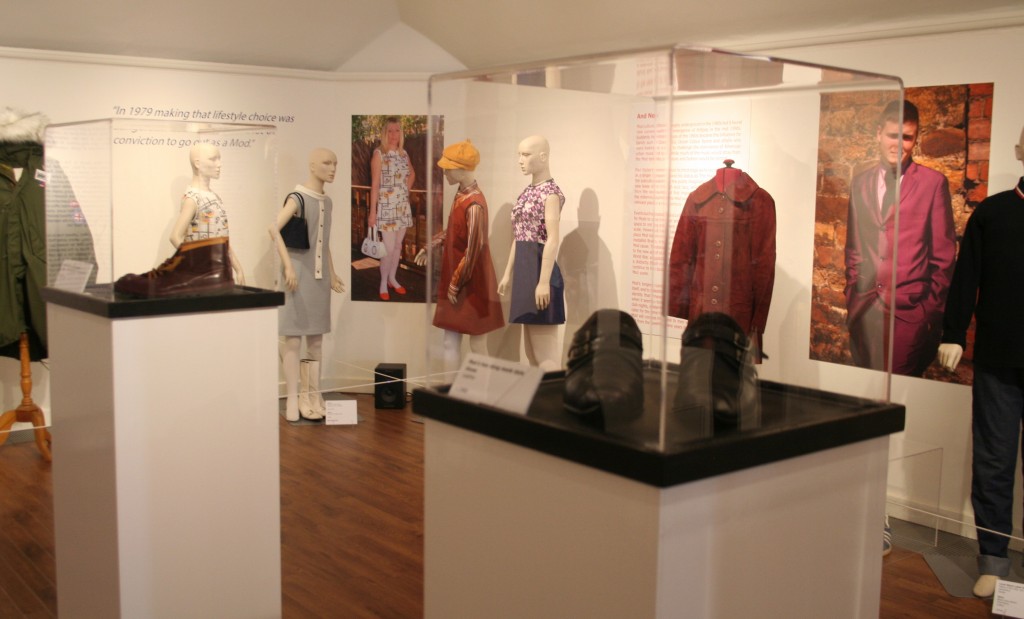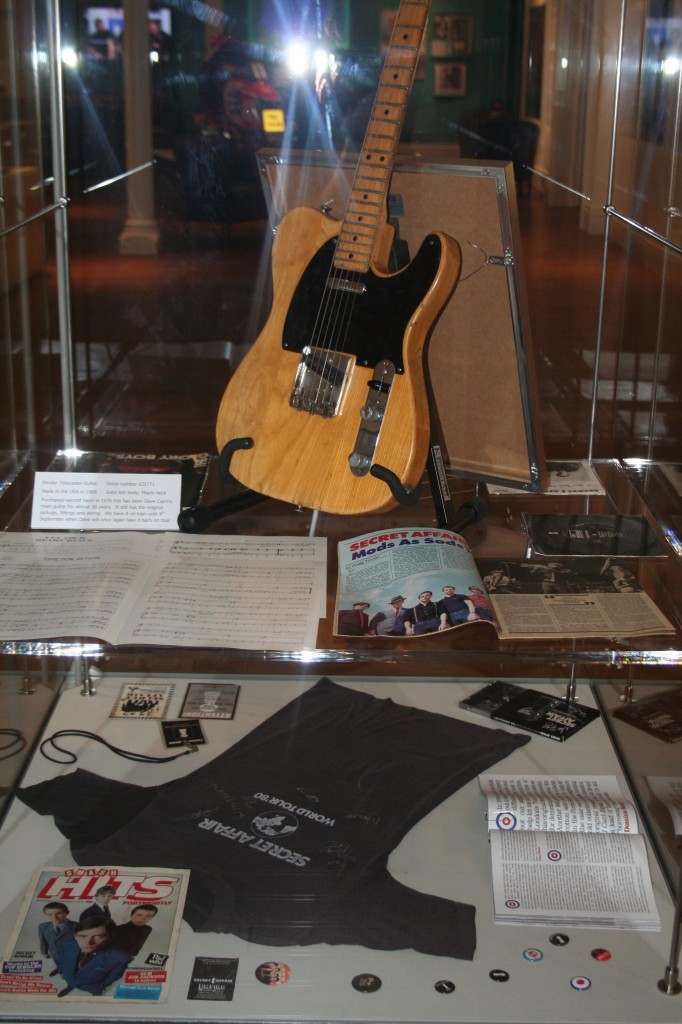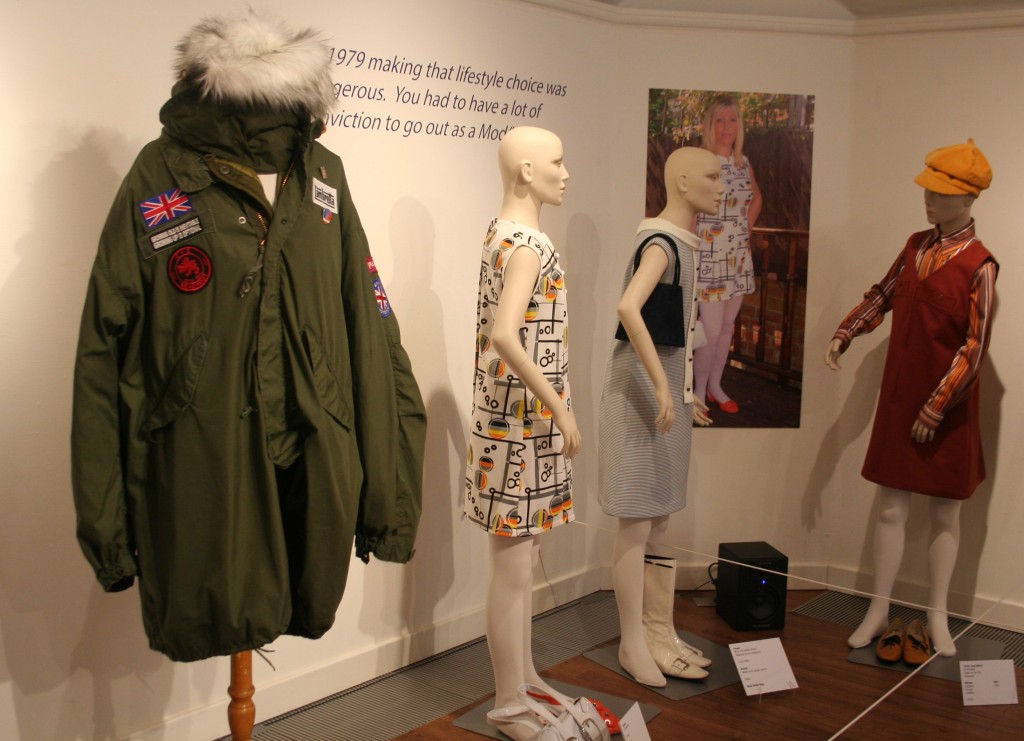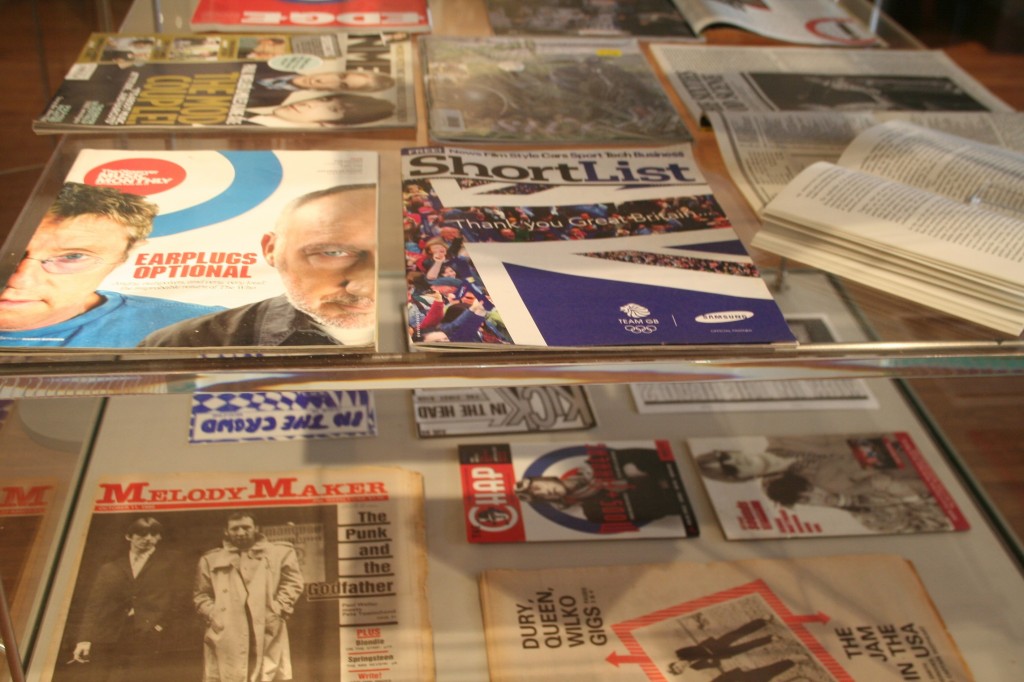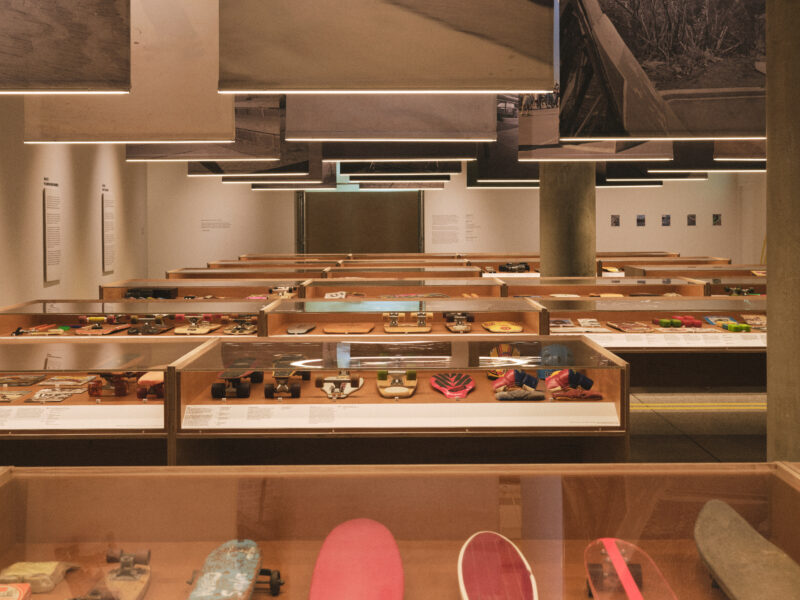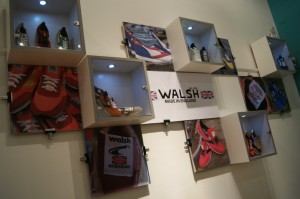Northampton Museum and Art Gallery’s latest major exhibition ‘MODS’ runs until 29th September 2013. It is curated by Tory Turk and Paul Lander. It features a large-scale mural by Jamie-Julien Brown, a selection of magazines from the Hyman Archive, film, scooters, authentic garments and a schedule of exciting live music performances. Below is a selection of exhibition photographs and excerpts from the exhibition text, written by Dr Nathan Wiseman-Trowse.
The Mod scene in Northampton, as with many other provincial towns, was influenced by what was happening in London.
Images and sounds from the metropolitan Mods would filter back to the Home Counties inspiring young men and women who wanted to replicate and be a part of this vibrant new subculture.
For many the scooter provided the chance to easily make the trip to London to buy clothes and records or to go to gigs or clubs. But a home-grown scene was emerging thanks to a handful of Mod devotees. The Who would play the Maple Ballroom on Bridge Street in 1965 with The Kinks appearing two years later, but the venue would go on to have a significant role for the town when it was rechristened Shades in 1969. Owner Pete Mace, inspired by American clubs at the time, helped to cater for the Mods taste in soul and rhythm and Blues that would rival the infamous Wigan Casino, attracting crowds from across the country.
For the Mods taste was all-important. What you looked like, what you danced to, where you went to have a good time were all markers of the values that made up the Mod subculture. Mod style encompasses a whole package made up of the clothes, the music, the scooters, and the way Mods carry themselves. Looking sharp and thinking sharp, spectacular display, community and individuality, all these factors go to make the Mod from whichever era.
Like the Teddy Boys that came before them, Mods emerged first in the metropolitan suburbs, the sons and daughters of families enjoying the fruits of post war Britain. Influences included Beatnik culture, modern jazz (hence ‘Mod’, or ‘The Modernists’), the blues, European cinema and existentialism. Mod style offered young people a chance to indulge in fashion for fashion’s sake, a particular influence being Italian tailoring for those who could afford it. As Mod moved out into the provinces in the early 1960s the local high street retailer might have to suffice, but the dedication to a sharpness of style would be just as important.
In the mid-sixties American rhythm and blues and soul music became the Mod soundtrack. London clubs and pubs such as The Marquee, The Flamingo, The Scene, The Station Hotel in Richmond or The Goldhawk Road Social Club provided a chance for Mods to dance the night away to the latest American imports or see the likes of Georgie Fame, Geno Washington or The High Numbers, later to become the high priests of British Mod, The Who. The sharpness of style was replicated in the edginess acquired from the pills that would keep young Mods dancing all night, alcohol never played much of a role.
By the mid-sixties the mainstream had caught up, both popularising the style through the myth of Swinging London and popular TV programmes, and reviling the scene during the moral panic surrounding the ‘beachfront riots’ with the rockers on the south-east coast in 64 and 65. The Who, The Small Faces, The Kinks and other bands enjoyed widespread success articulating a sense of inherent Englishness whilst attacking the very culture that had spawned them.
As the sixties decade drew to a close Mod would dissipate, as all subcultures do, along a variety of lines, spawning both the British hippies and the harder, more proletarian Skinheads. But its legacy of a specifically British youth vernacular, albeit one that owed much to America and Europe, would ensure its enduring significance in the decades to come.
During the 1970’s a new powerful subculture emerged – Punk. Initially in New York, but soon in London, young people rebelled against the post war consumerism, economic recession and emerging right wing politics. As the decade progressed, Punk spawned a plethora of youth subcultures, including the revival of Mod.
The Jam’s debut album In The City (1977) heralded a more contemporary vision of Mod, one that fused the sharp dandy-esque style of the sixties with a hard, Punk sound and a biting social commentary. While the Mod scene had largely been driven underground during the late sixties and early seventies The Jam and Paul Weller provided a highly visible image of the modern Mod that would inspire thousands of young people across the UK. Another important inspiration was Frank Roddam’s 1979 film adaptation of The Who’s 1973 concept album Quadrophenia, featuring Phil Daniels as Jimmy, the archetypal disaffected office clerk who initially finds a sense of place within the Mod scene only to walk away from it (and a crashed scooter) as adulthood beckons. With Weller on Top of the Pops and Quadrophenia in the cinemas Mod style and culture was once again making itself felt.
This second wave of Mod differed from its sixties incarnation in a number of ways. Firstly, where sixties Mods aligned themselves with the new, whether that be modern jazz or the exotic sounds of American R ‘n’ B, Mods in the late seventies and early eighties were combining a nostalgia for a lost youth phenomenon with a specifically British sensibility that Punk was already engaging with. Secondly, at least in its more popular forms, the influence of soul music was less prominent. Bands such as The Lambrettas, The Merton Parkas, Secret Affair and The Purple Hearts would both hark back to and update the beat groups of the sixties, while fanzines such as Maximum Speed and the emergent soul all-nighters, weekenders and scooter rallies would provide a sense of communion for this latest incarnation. Weller would split The Jam in 1982 to pursue a more contemporary form of soul music with The Style Council, but by then Mod had already regained its foothold in British popular culture.
While Mod culture continued largely underground as the 1980s came to a close, it found new currency with the emergence of Britpop in the mid 1990s. Suddenly the British groups of the 1960s, became the influence for bands such as Oasis, Blur, Ocean Colour Scene and others who were looking for a way to challenge the dominance of American urban music and rock. While much of the music would stray from the Mod template, Mod style and fashion would be central.
While events such as Modstock and Le Beat Bespoké provided opportunities for Mods to come together, the internet allowed Mod culture a space to not only document its past but also to thrive on a global scale. However it would take the 2012 London Olympics to truly place Mod back in mainstream public consciousness. Olympic gold medallist Bradley Wiggins was candid about his dedication to the Mod cause. The sharpness of Mod fashion was a welcome response to the new age of austerity, much as it had been after the Second World War, and guitar bands once again saw a way of articulating a distinctly British vernacular. Current indie darlings The Strypes continue to hark back to the sixties beat sound so beloved of the Mod scene.
Mod’s longevity can be attributed both to its ability to reinvent itself, and to its dedication to style, the beat and a sense of national identity that is hard to locate in many other subcultures. Even when it seems to have disappeared a whole infrastructure of gigs, club nights, scooter runs, webzines and online retailers continue to cater for the scene. Far from being just another period subculture Mod will continue to appeal to young men and women looking to stand out from the crowd for many years to come.

Words: Tory Turk
